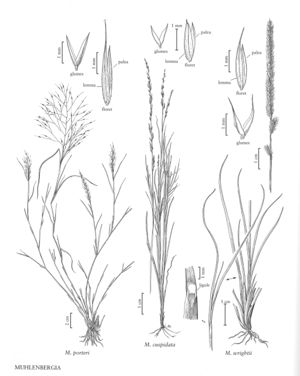Difference between revisions of "Muhlenbergia wrightii"
FNA>Volume Importer |
FNA>Volume Importer |
||
| Line 17: | Line 17: | ||
-->{{Treatment/Body | -->{{Treatment/Body | ||
|distribution=Okla.;N.Mex.;Tex.;Utah;Ariz.;Colo. | |distribution=Okla.;N.Mex.;Tex.;Utah;Ariz.;Colo. | ||
| − | |discussion=<p>Muhlenbergia wrightii grows in gravelly prairies, on rocky slopes, and in meadows on granitic, sandstone, or limestone-derived soils, at elevations of 1100-3000 m. Its range extends from the southwestern United States to northern Mexico.</p> | + | |discussion=<p><i>Muhlenbergia wrightii</i> grows in gravelly prairies, on rocky slopes, and in meadows on granitic, sandstone, or limestone-derived soils, at elevations of 1100-3000 m. Its range extends from the southwestern United States to northern Mexico.</p> |
|tables= | |tables= | ||
|references= | |references= | ||
| Line 26: | Line 26: | ||
-->{{#Taxon: | -->{{#Taxon: | ||
name=Muhlenbergia wrightii | name=Muhlenbergia wrightii | ||
| − | |||
|authority=Vasey ex J.M. Coult. | |authority=Vasey ex J.M. Coult. | ||
|rank=species | |rank=species | ||
| Line 33: | Line 32: | ||
|basionyms= | |basionyms= | ||
|family=Poaceae | |family=Poaceae | ||
| − | |illustrator=Linda A. Vorobik | + | |illustrator=Linda A. Vorobik;Annaliese Miller |
| + | |illustration copyright=Utah State University | ||
|distribution=Okla.;N.Mex.;Tex.;Utah;Ariz.;Colo. | |distribution=Okla.;N.Mex.;Tex.;Utah;Ariz.;Colo. | ||
|reference=None | |reference=None | ||
| Line 39: | Line 39: | ||
|publication year= | |publication year= | ||
|special status= | |special status= | ||
| − | |source xml=https:// | + | |source xml=https://jpend@bitbucket.org/aafc-mbb/fna-data-curation.git/src/f50eec43f223ca0e34566be0b046453a0960e173/coarse_grained_fna_xml/V25/V25_740.xml |
|subfamily=Poaceae subfam. Chloridoideae | |subfamily=Poaceae subfam. Chloridoideae | ||
|tribe=Poaceae tribe Cynodonteae | |tribe=Poaceae tribe Cynodonteae | ||
Revision as of 20:37, 16 December 2019
Plants perennial; cespitose, not rhizomatous. Culms 15-60 cm tall, 1.5-2.5 mm thick, compressed, erect, not rooting at the lower nodes; internodes mostly hispidulous or glabrous, strigose to hispidulous below the nodes. Sheaths usually shorter than the internodes, smooth or scabridulous, compressed-keeled, not becoming spirally coiled when old; ligules 1-3(5) mm, membranous, truncate; blades 1.4-12 cm long, 1-3 mm wide, flat to folded, smooth or scabridulous abaxially, strigose adaxially. Panicles 5-16 cm long, 0.2-1.2 cm wide, spikelike, dense; primary branches 0.3-2 cm, appressed; pedicels 0.1-1.4 mm. Spikelets 2-3 mm, dark green or plumbeous. Glumes equal, 0.5-1.6 mm, usually 1/2 - 3/4 as long as the lemmas, 1-veined, scabridulous on the veins, acute or obtuse, abruptly narrowed to a short (0.5-1 mm) awn; lemmas 2-3 mm, lanceolate, appressed-pubescent on the basal 1/2 - 3/4 of the midveins and margins, hairs about 0.5 mm, apices scabridulous, acute to acuminate, mucronate, mucros 0.3-1 mm; paleas 1.9-3 mm, lanceolate, intercostal region pubescent, apices acute to acuminate; anthers 1.3-1.8 mm, greenish. Caryopses 1.2-2 mm, fusiform, brownish. 2n = unknown.
Distribution
Okla., N.Mex., Tex., Utah, Ariz., Colo.
Discussion
Muhlenbergia wrightii grows in gravelly prairies, on rocky slopes, and in meadows on granitic, sandstone, or limestone-derived soils, at elevations of 1100-3000 m. Its range extends from the southwestern United States to northern Mexico.
Selected References
None.
